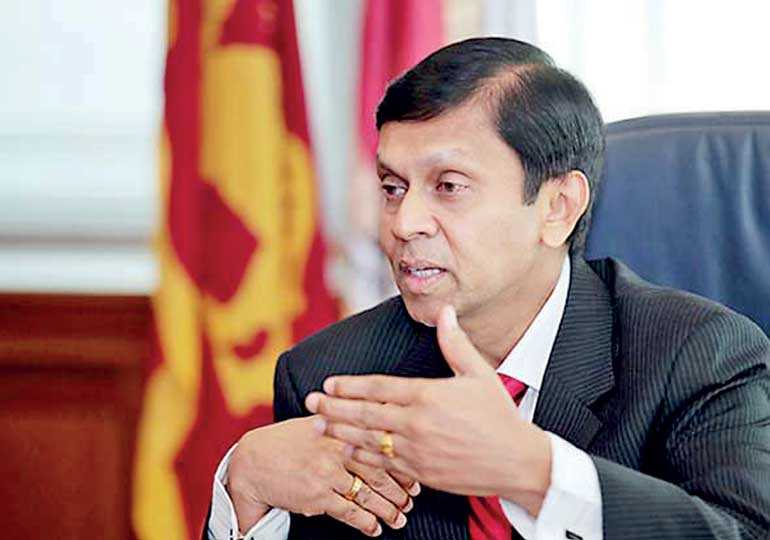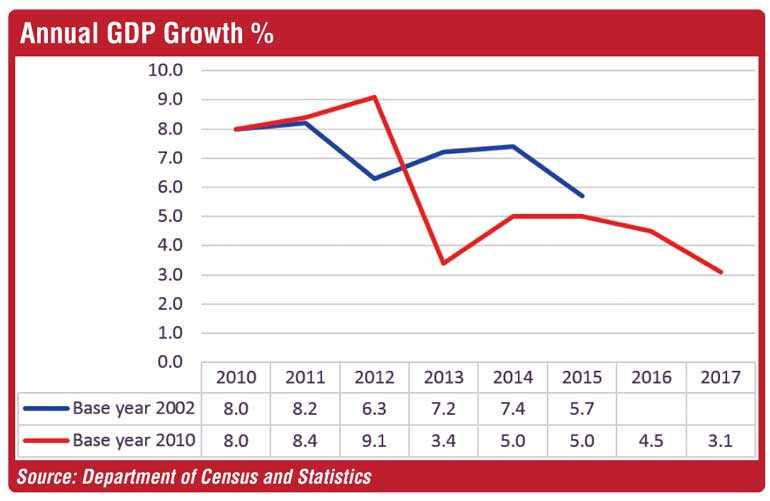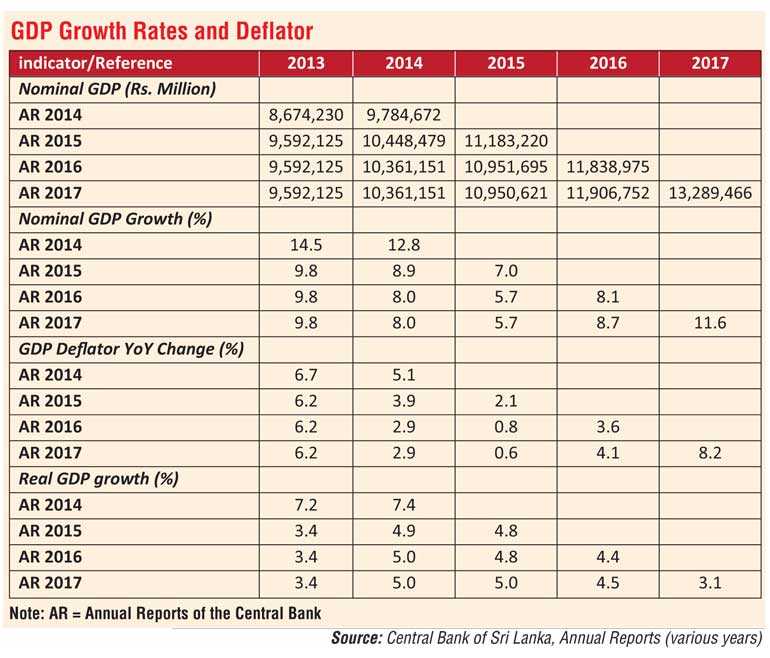Saturday Apr 19, 2025
Saturday Apr 19, 2025
Tuesday, 3 July 2018 00:00 - - {{hitsCtrl.values.hits}}

In his article titled ‘The Government’s growth scam’ which appeared in Daily FT of 26 June, former Central Bank Governor Ajith Nivard Cabraal (ANC) has wildly accused the compilers of national accounts on the grounds that they have manipulated the data since 2015 to exaggerate economic growth under the present Government (available at http://www.ft.lk/columns/The-Government-s-“growth-scam”-/4-657822).
A similar article by him appeared in Daily FT of 16 May 2017 under the title ‘The Rs. 231 billion mega growth scam’ (available at http://www.ft.lk/article/615333/The-Rs--231-billion-mega--growth-scam--).
In his recent article, ANC heroically states that the accusations raised by him in his previous article were met with a deafening silence by the Sri Lankan Government authorities, who strategically avoided the issue. The Opposition too did not add to pressure to highlight the ‘growth scam,’ according to him.
Malicious accusations
ANC’s articles contain politically-biased material orchestrated against the present Government, rather than any objective assessment of GDP computations. Both articles are filled with abusive words ridiculing the GDP compiling authorities. For instance, he mentions that the ‘growth scam’ has been carried out by a ‘Growth Manipulating Team’.
Of course, there is room for improvement in GDP compilation with constructive comments, but the types of unfounded accusations posed by ANC do not in any way contribute to such improvement, and they merely have adverse implications for the credibility of GDP numbers tarnishing the country’s image as regards data management.
Regrettably, the DCS, which is the country’s sole GDP data compiling authority, has not responded to the allegations made by ANC to date, according to my knowledge.
Given the complex technicalities involved in GDP computations, the public can be easily misled by the confusing statements and different datasets presented in ANC’s articles. These concerns prompted me to write this article so as to objectively clarify the methodologies underlying the country’s national accounts.
GDP as a reference point of economy’s health
The Gross Domestic Product (GDP), which measures the money value of all final goods and services produced in a country within a given period of time, is the most widely used reference point to gauge the health of a country’s economy. In addition, key macroeconomic variables such as the fiscal deficit, external current account deficit, debt stock and money supply are compared in relation to GDP to understand their movements over time and across countries.
GDP is also a handy indicator for private sector entrepreneurs and foreign investors to formulate their business plans. Hence, accuracy of GDP data is crucial not only for decision making both in public and private sectors locally but also for attracting foreign investment.
In the backdrop of complexities in collecting data on growing economic activities, compilation of GDP figures is always subject to varying margins of errors and omissions, and hence, no country has perfect GDP numbers. It is the responsibility of the authorities to ensure the accuracy of GDP data.
In Sri Lanka, the Department of Census and Statistics (DCS) has the sole responsibility of compiling GDP estimates. Prior to 2007, both the DCS and the Central Bank (CB) had compiled GDP data. Since then, CB has rightly given up the compilation task to avoid any conflict of interests, as it is also a user of GDP data for monetary policy formulation and macroeconomic analyses.
GDP computation for 2014
ANC points out that the nominal GDP figures and the GDP deflator for 2014 were revised four times in three years. The original figure of Rs. 9,785 billion appeared in CB’s Annual Report for 2015 was revised upward to Rs. 10,292 billion in July 2015 as an outcome of the “rebasing” exercise carried out by DCS. Since then, it was revised downward twice. These statistical revisions are characterised as politically motivated “growth scam” by ANC.
Most of the GDP growth revisions that have been done by CDS can be attributed to the recent rebasing of national accounts of Sri Lanka. The following Table shows the revised figures of GDP and GDP deflator based on different base years for the period 2013-2017 as appeared in the Central Bank Annual Reports of various years.

Rebasing GDP estimates
Rebasing of national accounts means the process of replacing an old base year with a new and a more recent base year so as to capture new economic activities and to adopt the latest international accounting practices prescribed by the UN in its System of National Accounts (SNA-2008).
In 2015, DCS changed the base year of national accounts from 2002 to 2010 which was considered as a normal year after the prolonged conflict in the north and east. The rebasing was a long process which began in 2011, according to DCS. In order to announce the continuing revisions of national accounts, the DCS has introduced a Data Releasing Calendar, in tandem with the rebasing exercise.
Rebasing enables the national account compilers to improve the quality of data to meet international benchmarks. It helps decision makers in the private and public sectors and foreign investors to use more accurate figures.
Rebasing obviously leads to change a country’s GDP growth rate under the new base year vis-à-vis the old base year. While some countries may have underestimated their GDP before rebasing some other countries may have overestimated the GDP. This is what Sri Lanka has experienced following the rebasing, as shown in the table and the chart.
The GDP growth rate derived from the series of base year 2010 is lower compared with the old series in 2013, 2014 and 2015, and it was higher in 2011 and 2012. In his articles, ANC highlights only the downward revision adopted for 2014, and avoids discussing the upward revisions that were done for the two years 2011 and 2012 which, in fact, fall within the period of the previous regime.
One could question as to why the national accounts authorities, or the ‘Growth Manipulating Team’ (using ANC’s terminology) show higher growth rates for those two years in the previous regime, if they really intend to exaggerate the growth rates during the present regime.
By looking at the downward growth trend up to 2017 (as shown in the chart), it is hard to believe that growth rates were overestimated in recent years, as claimed by ANC.
Restoring Central Bank’s lost autonomy commendable
The slowing down of growth is clearly a reflection of the economy’s increasing capacity constraints and policy ineffectiveness of the present and the previous governments. This is an issue that calls for a separate discussion, and it might be sufficient to mention here that the potential peace dividend gained following the cessation of the war in 2009 was squandered away by short-sighted economic policies adopted since then. The Central Bank, as the country’s monetary authority, had failed in its duty to correct the precarious situation, since its autonomy was surrendered to satisfy the political masters in the previous regime.
The present Government too has not been successful in resuscitating the ailing economy for various reasons. Nevertheless, the bold steps taken by the Central Bank in recent times to restore its lost autonomy by way of moving towards an independent inflation targeting monetary policy framework and a flexible exchange system are commendable.

GDP computations for 2015 and 2016
ANC, in his articles, points out that the nominal GDP as well as the GDP deflator for the year 2015 were revised downward on several occasions. Again, he identifies these revisions as manipulations.
As regards the numbers for 2016, ANC alleges that the GDP growth rate for that year should have been only 2.2%, instead of 4.5% as published in the CB’s Annual Report 2016. According to him, the ‘Growth Manipulating Team’ casually reduced the GDP value for 2015 to Rs. 10,952 billion, and simply shifted Rs. 231 billion of GDP from the year 2015 to 2016. On that basis, growth for 2016 was conveniently recorded at 4.4%.
That is a flawed argument, as ANC is arriving at the growth rate of 2.2% for 2016 by comparing two different GDP data sets based on the years 2002 (old series) and 2010 (new series). The figure that he uses for 2015 (Rs. 11,183 billion) belongs to the old series, while the figure for 2016 (Rs. 11,839 billion) belongs to the new series. Hence, these two incomparable figures cannot be used to compute the growth rate for 2016,
According to ANC’s calculations, GDP growth in 2016 should have been 5.9%, if no revision was made to GDP figure for 2015. This in itself defeats his previous argument that GDP growth is only 2.2% in 2016. In this calculation he uses the original GDP deflator change of 3.6%, instead of the updated rate of 4.1%, making this hypothetical exercise too wrong.
GDP computation for 2017
ANC alleges that the ‘Growth Manipulating Team’ took action to artificially ‘pump-up’ the nominal GDP for 2017 by a hefty Rs. 1,450 billion, although such an increase seemed impossible to justify in the context of subdued economic activities. The team, therefore, reduced this increase to Rs. 1,382 billion by raising GDP figure for 2016 from the original level of Rs. 11,839 billion to Rs. 11,907 billion, according to him. It is also alleged that the team has used a higher rate of change of GDP deflator at 8.2% in order to derive a credible GDP growth rate. In this manner, ANC claims, that the authorities were able to deliver a GDP in USD at an artificially “pumped-up” value of $ 87.2 billion (based on the conversion rate of Rs. 152/40 per USD) to the satisfaction of the “Growth Scam Masterminds”. According to ANC, nominal GDP value for 2017 has been over-stated by Rs. 322 billion.
He further notes that the GDP deflator for 2017 which has obviously been “picked” by the “Growth Manipulating Team” was the “balancing” number that suited their collateral purposes. This argument is a truism, as the GDP deflator, in any case, is a balancing number. That is why it is known as ‘implicit’ GDP deflator in national accounting terminology.
Wrap-up
Sri Lanka is among the very few developing countries that has had a fairly sound track record of maintaining internationally-recognised national accounts for many decades following the standards set by the United Nations.
According to its official documents, the DCS has been constantly revising its national accounts database so as to meet international standards by capturing new economic activities and by adopting most recent data compiling methodologies. This process of revisions might generate higher or lower GDP growth rates compared with the old series, and such discrepancies are unavoidable. It is unfair to misinterpret such revisions as politically-motivated manipulations.
While I cannot vouch for the accuracy of GDP data on behalf of DCS, there is hardly any evidence to prove that data are adjusted in an inappropriate manner to gain political mileage. If such unwarranted adjustments are made, Sri Lanka’s growth path would have been upward-sloping by now, in contrast to the currently experiencing downward-sloping growth path.
(Prof. Sirimevan Colombage, Emeritus Professor of Economics in the Open University of Sri Lanka, can be reached at [email protected].)